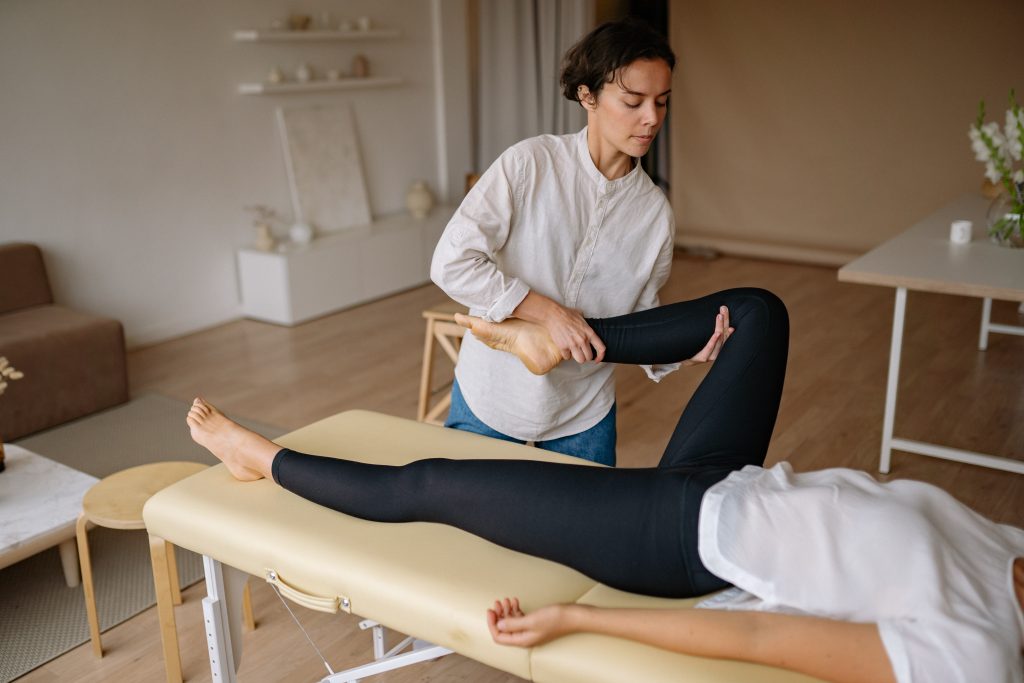Discover the essential precautions to keep in mind when embarking on postpartum physical therapy.
What Precautions Should I Consider When Starting Postpartum Physical Therapy?

Congratulations, new mom! You’ve successfully navigated the whirlwind of pregnancy, childbirth, and now it’s time to embark on your postpartum physical therapy journey. But before you dive headfirst into this exciting adventure, it’s important to consider a few precautions to ensure a safe and effective recovery process. Let’s explore what you need to know!
Understanding the Importance of Postpartum Physical Therapy
Postpartum physical therapy is not just your typical workout routine – it’s a specialized form of therapy designed specifically for new moms like you. The primary goal is to aid in your recovery from childbirth and address any physical issues that may have arisen during or after pregnancy.
When it comes to postpartum physical therapy, there are numerous benefits that can greatly enhance your journey toward regaining strength and function. One of the key benefits is that it promotes healing. After giving birth, your body undergoes significant changes, both internally and externally. Postpartum physical therapy helps to facilitate the healing process, allowing your body to recover more efficiently.
In addition to promoting healing, postpartum physical therapy also alleviates pain. Many women experience discomfort and pain in various areas of their body after childbirth, such as the lower back or pelvic region. Through targeted exercises and techniques, postpartum physical therapy can help to reduce pain and discomfort, allowing you to move more freely and comfortably.
Another important benefit of postpartum physical therapy is its focus on restoring pelvic floor and core strength. Pregnancy and childbirth can weaken the pelvic floor muscles, leading to issues such as urinary incontinence or pelvic organ prolapse. Postpartum physical therapy includes exercises specifically designed to strengthen these muscles, helping to prevent and address these complications.
Improving posture is another key aspect of postpartum physical therapy. During pregnancy, the body undergoes significant changes in order to accommodate the growing baby. This can often result in poor posture, which can lead to discomfort and pain. Postpartum physical therapy includes exercises and techniques to help improve posture, allowing you to stand and move with better alignment and less strain on your body.
Aside from the physical benefits, postpartum physical therapy also provides much-needed emotional support during this transformative phase of your life. Becoming a new mom can bring about a range of emotions, and having a supportive and understanding healthcare professional by your side can make a world of difference. Postpartum physical therapists are trained to provide not only physical guidance but also emotional support, ensuring that you feel heard, validated, and empowered throughout your recovery journey.
Common Postpartum Physical Issues
No two postpartum experiences are the same, but there are some common physical issues many women face. These can include diastasis recti (abdominal separation), weakened pelvic floor muscles, lower back pain, and poor posture. Postpartum physical therapy targets these specific issues and tailors treatments to your unique needs.
Diastasis recti, or abdominal separation, occurs when the connective tissue between the abdominal muscles stretches and weakens during pregnancy. This can result in a noticeable gap between the muscles, which can affect core strength and stability. Postpartum physical therapy includes exercises to help close the gap and strengthen the abdominal muscles, promoting better core function.
Weakened pelvic floor muscles are another common issue that many women experience after childbirth. These muscles play a crucial role in supporting the pelvic organs and maintaining bladder and bowel control. Postpartum physical therapy focuses on strengthening these muscles through targeted exercises, helping to improve pelvic floor function and reduce the risk of urinary incontinence or pelvic organ prolapse.
Lower back pain is a prevalent complaint among new moms. The physical demands of pregnancy and childbirth can put strain on the lower back, leading to discomfort and pain. Postpartum physical therapy includes exercises to help alleviate lower back pain, improve spinal alignment, and strengthen the muscles that support the spine.
Poor posture is another issue that many women face after giving birth. The changes in the body’s alignment during pregnancy can result in rounded shoulders, a forward head position, and an exaggerated curve in the lower back. Postpartum physical therapy addresses these postural imbalances through exercises and techniques that help to realign the body, promoting better posture and reducing strain on the muscles and joints.
In conclusion, postpartum physical therapy offers a wide range of benefits that are essential for new moms. From promoting healing and alleviating pain to restoring pelvic floor and core strength, improving posture, and providing emotional support, postpartum physical therapy plays a crucial role in helping you recover and thrive during this transformative phase of your life.
Finding the Right Postpartum Physical Therapist
Choosing the right postpartum physical therapist is key in ensuring a successful recovery journey. You want someone who not only understands the intricacies of postpartum care but also makes you feel comfortable and supported throughout the process.
Postpartum physical therapy is a specialized field that focuses on helping women recover from the physical challenges they may face after giving birth. This can include issues such as pelvic pain, diastasis recti (abdominal separation), urinary incontinence, and overall muscle weakness. By working with a knowledgeable and experienced postpartum physical therapist, you can address these concerns and regain your strength and mobility.
When searching for a postpartum physical therapist, prioritize those who specialize in women’s health and have extensive experience working with new moms. Look for certifications or additional training in pelvic floor rehabilitation, pre and postnatal care, and manual therapy techniques. These qualifications indicate that the therapist has received specialized education and training to effectively address the unique needs of postpartum women.
It’s also important to consider the therapist’s experience in the field. Find out how long they have been practicing postpartum physical therapy and ask about their success stories with previous clients. Hearing about the positive outcomes they have achieved can give you confidence in their abilities to help you on your recovery journey.
Don’t be afraid to ask questions when selecting your postpartum physical therapist. Inquire about their approach to treatment, their success stories with previous clients, and how they plan to tailor their techniques to your specific needs. Remember, the more informed you are, the better equipped you’ll be to make the right decision.
During your initial consultation with a potential postpartum physical therapist, they will likely assess your current physical condition and discuss your goals for therapy. They may perform tests to evaluate your pelvic floor strength, assess your posture and alignment, and identify any areas of muscle weakness or imbalance.
Based on this evaluation, the therapist will develop a personalized treatment plan that may include a combination of exercises, manual therapy techniques, and education on proper body mechanics and posture. They will work closely with you to ensure that the treatment plan aligns with your goals and addresses your specific needs.
Throughout your postpartum physical therapy sessions, your therapist will provide guidance and support as you work towards your recovery goals. They will monitor your progress, adjust the treatment plan as needed, and provide education on self-care techniques that you can continue at home.
Remember, postpartum physical therapy is not just about addressing physical issues; it’s also about providing emotional support during this transformative period in your life. A good postpartum physical therapist will create a safe and nurturing environment where you can openly discuss your concerns and receive the support you need.
By taking the time to find the right postpartum physical therapist, you are investing in your own well-being and setting yourself up for a successful recovery. Don’t hesitate to reach out to multiple therapists, ask for recommendations from your healthcare provider or other moms, and trust your instincts when making your decision. With the right therapist by your side, you can confidently embark on your postpartum recovery journey.
Precautions to Take Before Starting Postpartum Physical Therapy
Before you begin your postpartum physical therapy sessions, there are a few precautions you need to consider to ensure a smooth and safe recovery process.
Consulting with Your Healthcare Provider
It’s essential to consult with your healthcare provider before starting postpartum physical therapy. They can assess your overall health and ensure that you’re ready to engage in therapeutic activities. They may also provide valuable insights or restrictions based on your individual circumstances.
Assessing Your Postpartum Recovery Progress
Everyone’s postpartum recovery timeline is different. Before diving into physical therapy, take the time to assess your recovery progress and listen to your body. Give yourself adequate time to heal and be patient with the process. Remember, it’s a marathon, not a sprint.
Understanding Any Potential Risks or Complications
Being aware of potential risks or complications associated with postpartum physical therapy is crucial. Certain conditions, such as infections, incision site complications, or unresolved medical issues, may require specialized care or additional medical clearance before starting therapy. Your healthcare provider and physical therapist can guide you through any necessary precautions.
Preparing for Your First Postpartum Physical Therapy Session
The first session is an exciting step on your postpartum recovery journey. Here’s what you can expect!
What to Expect During the Initial Evaluation
Your first postpartum physical therapy session will likely involve an evaluation of your physical condition, movement patterns, and strength. The therapist will assess your pelvic floor muscles, core stability, posture, and any specific concerns you may have. This evaluation will serve as a baseline for designing your personalized treatment plan.
Necessary Documentation and Medical History
Before your first session, be prepared to provide your physical therapist with relevant medical and birth history. This information will allow them to understand your unique circumstances and modify treatments accordingly. Confidentiality and trust are paramount in this process, so rest assured that your information will remain secure and private.
Setting Realistic Goals for Your Postpartum Recovery
Setting realistic goals is an essential part of your postpartum physical therapy journey. Together with your physical therapist, you’ll identify both short-term and long-term objectives that align with your aspirations and physical capabilities. Celebrate each milestone achieved along the way – progress is progress, no matter how small!
Exercises and Techniques Used in Postpartum Physical Therapy
Your postpartum physical therapy sessions will likely consist of various exercises and techniques tailored to your specific needs. Let’s dive into some common practices!

Pelvic Floor Strengthening Exercises
Pelvic floor exercises, often referred to as Kegels, are instrumental in restoring strength and function to your pelvic floor muscles. In your therapy sessions, you will learn how to properly perform these exercises and incorporate them into your daily routine.
Core and Abdominal Strengthening Exercises
Targeting your core and abdominal muscles is crucial after pregnancy. Your physical therapist will guide you through exercises that engage these muscles, helping you regain stability, improve posture, and reduce any lingering diastasis recti.
Posture Correction and Alignment Techniques
Poor posture is a common issue postpartum, but fear not – postpartum physical therapy can help you overcome it. Your therapist will teach you proper alignment techniques that not only alleviate discomfort but also enhance your overall posture and body mechanics.
As you embark on your postpartum physical therapy journey, keep in mind these precautions to ensure a safe and effective recovery process. Remember, this is an exciting chapter in your life, so embrace the journey with enthusiasm and a positive mindset. You’ve got this, supermom!



